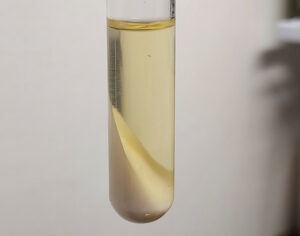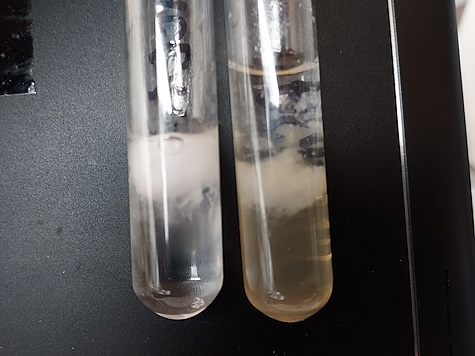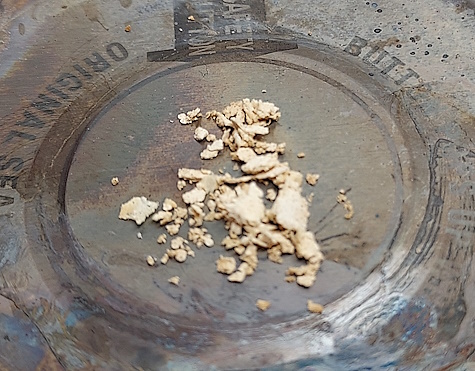A Cross Domain Bacteria (CDB) Production:
(Otherwise Known as Hydrogel)
Clifford E Carnicom
Feb 22 2024

CDB Polymer Produced via Phase Change Reaction
(liquid to solid)
A single compound produced by the Cross Domain Bacteria (CDB), a xenobiotic microbe under study by Carnicom Institute (CI) for the last several decades (nomenclature origin, 2014), has been assessed. There are dozens to scores of various compounds and culture forms that are known to exist from this synthetic biology that has been disclosed by CI; this particular one is of special contemporary importance. Bear in mind that this compound originates solely from the CDB metabolism and culture; no other agents (e.g., “vaccine”) are required to produce it. The fact that there are interactions between the CDB and purported “vaccines” is not at all diminished; it is, in fact, expected and already documented to some degree. The imposition of synthetic biology upon humans has a history much longer than many of us realize.
The proposed assessment of the identified compound from culture is as follows:
“A genetically engineered bacteria(i.e., synthetic biology in this case)-derived polymer containing polyvinyl alcohol (PVA), polylactic acid (PLA), and calcium ions. The polymer backbone consists of vinyl functional groups and includes alcohol, vinyl ester, and amide/protein functional groups.”
A four word version is plastic, protein, and blood clots. The material, is in essence, a hydrogel.
As to whether such a compound could have numerous biomedical applications (aka synthetic biology as applied to human biology), the answer is a resounding yes. These applications revolve around the development and use of hydrogels and related materials in human tissue and/or bone integration.
______________________________________
End of Short Version
The assessment derives from the following testing methods:
1. Measured or observed properties of a particular and specific material that are produced solely by the CDB in culture form.
2. Ultraviolet Spectroscopy (UV)
3. Near Infrared Spectroscopy (NIR)
4. Qualitative Chemistry
5. Conductivity
6. pH
7. Thermodynamics
8. Solubility
9. Reasonably sophisticated chemometric analysis that attempts to synthesize the chemical nature of the material in a combined sense, dependent upon measured properties.
10. Spectroscopy and chemical reference sources.
The measured or observed properties of the substance are:
1. Smokes at 300 deg C
2. Charred at 450 deg C
3. White to off white color.
4. Produces a phase change from liquid to solid when alcohol or acetone is added to solution
5. pH of solution prior to alcohol or acetone addition is approximately 3.5
6. Contains polymer forming functional groups
7. UV absorption at 205 nm and 265 nm.
8. Calcium ions are present
9. Pliable
10. Water soluble
11. Insoluble in acetone
12. Insoluble in alcohol
13. Slightly soluble in sulfuric acid
14. Vinyl functional groups
15. Not electrically conductive
16. Forms a tan colored precipitate when NaOH-KOH is added to the compound dissolved in water
17. NIR indicates following functional groups are present: alcohol, vinyloxy, amide/protein/polyamide, alkene
18. Originates solely from CDB culture metabolism.

Phase Change Comparison Control Test
Polyvinyl Alcohol (left) vs. CDB Culture (right)
The photograph above shows a control comparison phase change test between polyvinyl alcohol (pure control solution) and a primary solution from the CDB culture. Polyvinyl alcohol is a dominant component of many hydrogels. Hydrogels, in general, are highly biocompatible materials that integrate well within human tissue because of their water absorption and stability characteristics combined.
Polar (electrical charge separation) solutions such as acetone and alcohol can induce a phase change in polyvinyl alcohol, changing a liquid into a solid. This is what is occurring on the left side of the photograph. It shows a control sample of pure polyvinyl alcohol with acetone introduced. The change has an appearance similar to that of a precipitate, but in this case it is not a precipitate; it is a phase change from liquid to solid form.
The tube on the right produces a similar reaction. This tube, however, contains a primary product of the CDB culture, a water soluble form discussed extensively in previous papers. This is one of the first indications that the CDB produces a material akin to polyvinyl alcohols. Extensive testing reported above confirms this similarity, and the assessed compound fully qualifies in the hydrogel material class.
Polyvinyl alcohol or related compounds were some of the early infrared findings within CI research years ago. This work establishes the existence of it or related compounds at a much higher level of certainty. The inclusion of calcium within the isolated copolymer raises numerous questions and problems regarding calcium disruption or misappropriation in human health. Joint and dental issues have long been a part of CI health research history (e.g., 2016).

Solid form of CDB Polymer after Drying (material is pliable)

CDB Polymer Thermodynamic Property Testing
The last topic to discuss here will be the potential applications of a compound of this nature. A couple of questions are in order:
1. Is this material suitable for hydrogel applications?
2 Is it suitable for biomedical applications, and if so, what type?
To the first question, the answer is yes. Polyvinyl alcohol (PVA) is a well established hydrogel material that is known for biocompatibilty, water solubility, and its ability form a gel material. Polylactic acid (PLA), a thermoplastic, can also be modified to serve hydrogel applications. Thermoplastics can be reshaped to assume varying form.
The linking of polymers takes place by a process known as cross-linking. Calcium ions can crosslink both PVA and PLA chains to form a copolymer, and this stabilizes the hydrogel network and makes it more “tunable”. The presence of alcohol, vinyl ester, and amide/protein functional groups further enhances the cross-linking capability.
As to whether the material is suitable for biomedical use (or, in this case, aka synthetic biology use), a few of the applications for this hydrogel form include that it :
1. Can be used for tissue engineering, support of cell growth, tissue replacement, and regeneration. Can be used for cartilage and bone repair and regeneration.
2. Can deliver and encapsulate “drugs” in a controlled and target manner.
3. Can be used as a biosensor that responds to specific signals, allowing for monitoring or telemetry use.
Commercial products with similar chemical properties and nature exist.
_______________
Note: Extensive distribution or disclosure of the above information is unlikely.
_______________
Clifford E Carnicom
Feb 22, 2024
Born Clifford Bruce Stewart, Jan 19 1953.




